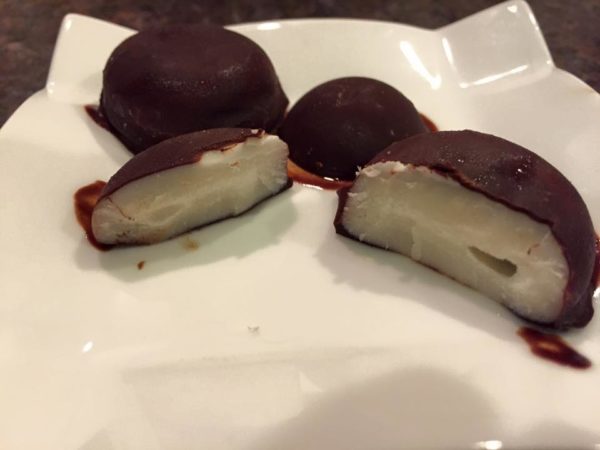The Secret to Avoiding Winter Exhaustion: 7 Strategies for Keeping Warm While Nourishing Yourself With Fresh, Whole, Gluten Free, Living Foods
By Ritamarie Loscalzo

The winter months can leave you with the feeling of exhaustion, as you expend so much energy dealing with cooler mornings, chilly evenings, and days when snuggling under a blanket with a warm drink or bowl of hot soup sounds delightful. There is less sunlight, so your Vitamin D levels may plummet, causing you to feel extreme fatigue, as well as other exhaustion symptoms, including muscle aches and pains, inability to think clearly and weakness. Eating well this time of year is more important than ever, and including an abundance of fresh, whole, gluten free, living foods is vital to keeping you healthy at this time of year.
Soups, stews, casseroles, pizza, lasagna, hot cocoa, and warm breakfast cereal are popular winter foods. Along with piping hot, steamy bowls of soup, these foods warm your insides and comfort you through the cold short days and long winter nights.
Unfortunately, temperatures above 118 ° F Fahrenheit destroy the enzymes, vitamins and phytochemicals and denature the proteins, resulting in food that is less than nutritionally beneficial. Eating an abundance of fresh, raw plant based foods is best for your health, yet the thought of eating a cold salad or drinking a frosty smoothie on a cold winter day is not particularly appealing when you’re trying to keep warm. Wouldn’t it be nice to be able to eat foods that heat up your insides and contain the maximum nutritional benefit of fresh, whole living foods?
A common misconception is that raw foods are, by design, cold foods. Actually, this is far from the truth. When winter rolls around, it’s easy to create delicious raw foods dishes that warm the body from a both a thermal and energetic perspective, balance your energy levels and combat tiredness.
Confused? Well, let me explain. In several traditional medicine practices, most notably, Chinese and Ayurvedic medicine, the concept of hot vs. cold plays an important role in food selection. Diseases, people, foods, and emotions can all be classified as hot, cold or somewhere in between. When you think about warm or hot, you probably think about temperature.
In Chinese medicine, every food is believed to have an effect on the body’s metabolic temperature, which is different from the body temperature that you measure with a thermometer. Metabolic temperature is the heat energy generated through all your organ systems from the food that you eat and that your digestive system burns.
Still confused? Let me give a few examples. Ginger and cayenne are energetically warm. Even if served as part of a cold dish, they have the ability to push the energy deep and push the blood up and out to the surface of the body, thus raising the metabolic temperature.
If you’d like to keep healthy throughout the winter, stay warm, enjoy increased energy and avoid winter exhaustion symptoms, and enjoy the benefits of a diet that is mostly or exclusively fresh living foods, read on for a variety of practical strategies for creating warming raw food meals.
Living foods can be heated to 110° F and still maintain their aliveness, so you can enjoy hot soup and maintain the life-giving properties of the foods in it at the same time. And, while 110°F may not seem very hot, compared to boiling temperature at 212°F, 110°F does, indeed, feel hot to the touch. Think about how a hot tub heated to 104 ° F feels if you have any doubt. Heated living foods should be eaten right away, because they’ll cool down a lot more quickly than foods cooked at high temperatures.
Seven Strategies for Staying Warm with Living Foods
Below is a summary of ways to enjoy living foods to warm your insides this winter. This is excerpted from an article called Staying Warm with Living Foods I wrote last year for Purely Delicious Magazine, which can be found on my Free Articles page. Skip the exhaustion and enjoy the pure energy of warm living foods.
1- Make creamy living foods soups and sauces by blending green vegetables, nuts and seeds. There are several heating options. You can heat them by starting with hot water (between 110 and 120 degrees). With a high speed blender like the Blendtec or Vitamix, you can start with room temperature water and blend for longer than usual until the soup feels hot to touch. Pour the hot soup or sauce over chopped or grated raw vegetables to make a warm and delicious soup or stew.
You can gently heat raw soups and stews in a saucepan on the stove, using a digital thermometer to monitor the temperature to be sure it does not go above 110° F, so you don’t destroy any of the nutrients. An electric skillet can be used to warm foods if set to warm. Elysa Markowitz, in her delightful book, Warming Up to Living Foods, recommends the Rival electric skillet because it can keep the food temperature at or below 105° F.
A coffee warming plate can be used to warm soups. This is the part of an electric coffee maker that keeps the coffee warm after it has been brewed.
2- Learn to make hearty raw dishes like stews, casseroles, pizza, calzones, enchiladas and lasagna and heat them in your Excalibur dehydrator. The shelves are large enough to fit a casserole or baking dish and as many shelves as necessary can be removed to accommodate the depth of the dish. I’ve made raw lasagna and taken it out of the dehydrator only to be accused by raw food friends of eating cooked food because it looked so much like cooked lasagna. Raw pizza right out of the dehydrator is very comforting and delicious. Get a good Living Foods Recipe Book for complete details on how to make these very satisfying, very nutritious foods.
3- Make or buy dehydrated crackers and breads created from ingredients such as sprouted nuts, seeds, and grains combined with vegetables and spices. These are very comforting and warming on cold days. They’re loaded with nutrients, leaving you energized rather than exhausted, as baked goods often do. There are lots of recipe books and websites that have delicious and easy to prepare recipes. Warm breads and crackers taste great right out of the dehydrator!
A convection oven or a digitally controlled oven that can be set as low as 100°F can be used to warm living food recipes like lasagna, pizza , stews, and casseroles. Convection ovens even have fans, which make them useful for food dehydration.
4- Internal fire can be generated by the judicious use of herbs and spices. Nothing gets the digestive fire going like a sprinkle of ginger or cayenne pepper! If physically warming your food is not an option due to time or equipment constraints, then the liberal use of warming spices can create internal warmth. The warming herbs and spices are: Basil, Chili peppers, Cinnamon, Clove, Dill, Fennel, Garlic, Nutmeg, Onion, Parsley, Rosemary, Vinegar and Wasabi.
5- The Chinese medicine approach to classifying foods as warming, neutral and cooling can be used to create raw winter meals. Since each food has an effect on the body’s metabolic temperature, we can choose warming foods in cold winter to soothe and nourish. Foods that take longer to grow are generally more warming than foods that grow quickly. Most of the root vegetables, including carrot, potato, onions, rutabaga, parsnip, burdock and garlic, fall into the warming foods category. Corn and most nuts and seeds are also warming.
Grains tend to be warming as well. Sprouted grains can be hearty and comforting cold weather foods. Many of the grains can be sprouted and made into dehydrated breads, crackers, pizza crusts and cereals. Sprouted buckwheat makes an excellent granola and crunchy breakfast cereal. Served with warm nutmilk, sprouted buckwheat makes a hearty, warming breakfast. Oats can be sprouted and eaten as a breakfast cereal. Topped with cinnamon and nutmilk, sprouted oat porridge makes a great breakfast in the winter. Be cautious about eating oats if you have gluten intolerance, as oats contain a small amount of gluten. Sprouted Quinoa can be made into an excellent tabouli, or warmed and turned into a creamy soup base or cereal.
6- Delicious, warming vegetable dishes can be made by a process I like to refer to as cold sautéing. Start with vegetables that fall into the warming foods category, such as cabbage, collard greens, cauliflower, mustard greens and watercress. Lightly salt vegetables with a whole, unrefined salt, such as Himalayan or Celtic and massage the greens to break down the cell walls and release the nutrients. Allow to sit for 15 minutes or longer. You can speed up the process by covering with a weighted plate or placing in a macrobiotic tool called a salad press. Massage again, and then add dressing of your choice.
The salting and massaging wilts the vegetables and makes them more digestible. Cooking also breaks down the cell walls, at the expense of destroying enzymes, vitamins and phytochemicals. Using this technique, you get the best of both the cooked and raw worlds. You release more of the nutrients than you would by simply eating raw, and you preserve the heat sensitive nutrients that cooking destroys.
One of my favorite dishes is curried vegetables, a very satisfying cold weather food. I use the cold sautéing process described above, make a curry sauce by blending nuts, seeds or coconut with water and curry seasonings, mix the vegetables with the sauce and dehydrate for 3-4 hours or until warm and soft. Broccoli with cheese sauce is another favorite. Broccoli is covered with a favorite nut or seed cheese sauce and dehydrated 4-6 hours. We never seem to be able to make enough of it to satisfy everyone’s appetite!
7. Warm beverages are very soothing and satisfying in the cold weather. Warm apple cider, a winter favorite, can be made by juicing apples, spicing with cinnamon, cloves, cardamom and ginger and warming using any of the methods described above.
My kids love raw hot cacao. I simply make nut milk using warm water, add cacao powder plus a sweetener like dates, agave, or yacon, and blend until smooth and warm. We serve it in mugs and even the neighbors and cousins love it! Finally, hot herbal tea is very soothing. You can get premade tea bags or make your own herbal blends. Hot water with lemon juice and/or freshly grated ginger warms me up on a cold day. Last winter was so unusually cold that I had an almost constant desire for hot tea. I bought an automatic hot water pot, which quickly warms water. I use the warm water not only for tea, but for soup and nut milk bases.
By now, the dreary prospect of cold salad for dinner all winter should be faded and the vision of plates of warm and comforting, nutrient dense, vital, and delicious living foods meals should be filling your heads, like the sugarplums dancing in the heads of the children in the Night before Christmas poem.
Follow these guidelines and you’ll soon be on your way to a healthy and vibrant, high energy winter. Exhaustion symptoms become a thing of the past.
Enjoy your adventure into the wonderful world of warm and living foods!
Recipe Resources
The following books contain delicious recipes for warming living foods:
• Markowitz, Elysa. Warming Up to Living Foods
• Dr. Ritamarie’s Feast Your Way to Health e-book
• Frederic Patenaude’ s Raw Winter Recipe Guide
References:
• Haas, Elson M. Staying Healthy With the Seasons.
• Pitchford, Paul. Healing With Whole Foods: Asian Traditions and Modern Nutrition (3rd Edition)
• Cousens, Gabriel. Conscious Eating
• Sommers, Craig. Raw Foods Bible.
Post your questions and comments about this topic below. Share your favorite recipe with us!
Share this:

Are you feeling stuck?
Do you feel as if something is missing from your practice that's keeping you from delivering breakthrough outcomes for your clients?.
Recent Posts
Our Programs
Nutritional Endocrinology Practitioner Training (NEPT)
The Mastery and Certification tier is our flagship program and provides everything you need to feel confident as a practitioner who knows how to get results that lead to healthy and happy clients.
Functional Assessment Mastery
Explore the relationships between the most important hormones and their relationship with nutrition.
Functional Nutrition Mastery
Learn how to support your clients to eat and supplement in a way that reduces and eliminates chronic symptoms.
Medical Disclaimer: The information on this website is not intended to replace a one-on-one relationship with a qualified health care professional and is not intended as medical advice. It is intended as a sharing of knowledge and information from the research and experience of Dr. Ritamarie Loscalzo, drritamarie.com, and the experts who have contributed. We encourage you to make your own health care decisions based upon your research and in partnership with a qualified health care professional.
Disclosure: Sometimes (but not always), when I share resources in my programs, newsletter, and on my website, I'm using an affiliate link, which means I do make money if you buy. My credibility is extremely important to me; therefore, I only endorse the products, services, and people I believe in. DrRitamarie.com is independently owned and the opinions expressed here are my own.
Click here to see our Privacy Policy.












A good diet will keep our bodies healthy and full of energy. exercise regularly and balance your mind and body in order to keep your body healthy.
It’s an remarkable piece of writing in favor of all the internet viewers; they will get benefit from it I am sure.